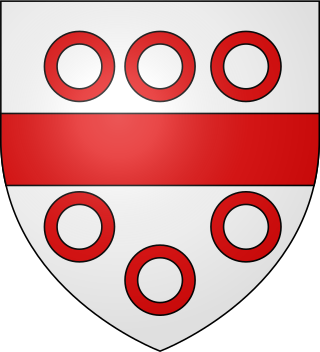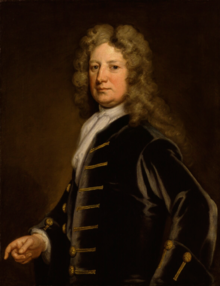
Baron Audley is a title in the Peerage of England first created in 1313, by writ to the Parliament of England, for Sir Nicholas Audley of Heighley Castle, a member of the Anglo-Norman Audley family of Staffordshire.

Baron de Ros of Helmsley is the premier baron in the Peerage of England, created in 1288/89 for William de Ros, with precedence to 24 December 1264. Premier baron is a designation and status awarded to the holder of the most ancient extant barony of the Peerage of England. Before the Dissolution of the Monasteries the Prior of the Order of St John in England was deemed the premier baron.

Baron Mowbray is a title in the Peerage of England. It was created by writ for Roger de Mowbray in 1283. The title was united with the Barony of Segrave in 1368, when John Mowbray, 1st Earl of Nottingham and 5th Baron Mowbray, succeeded to that title. His successor was named Duke of Norfolk. With the childless death of Anne Mowbray, 8th Countess of Norfolk, in c.1481, the Barony went into abeyance between the Howard and Berkeley families, and both styled themselves Baron Mowbray and Seagrave.

Baron Hastings is a title that has been created three times. The first creation was in the Peerage of England in 1290, and is extant. The second creation was in the Peerage of England in 1299, and became extinct on the death of the first holder in c. 1314. The third creation was in the Peerage of England in 1461, and has been in abeyance since 1960.

Baron de Clifford is a title in the Peerage of England. It was created in 1299 for Robert de Clifford (c.1274–1314), feudal baron of Clifford in Herefordshire, feudal baron of Skipton in Yorkshire and feudal baron of Appleby in Westmoreland. The title was created by writ, which means that it can descend through both male and female lines. The Norman family which later took the name de Clifford settled in England after the Norman Conquest of 1066 and was first seated in England at Clifford Castle in Herefordshire. The first Baron served as Earl Marshal of England but was killed at the Battle of Bannockburn in 1314. His 8th generation descendant the 11th Baron, was created Earl of Cumberland in 1525, whose grandson the 3rd Earl was a noted naval commander. On the latter's death in 1605, the earldom passed to his younger brother, the 4th Earl.

Baron Willoughby de Eresby is a title in the Peerage of England. It was created in 1313 for Robert de Willoughby. Since 1983, the title has been held by Jane Heathcote-Drummond-Willoughby, 28th Baroness Willoughby de Eresby.

Baron Berners is a barony created by writ in the Peerage of England.

Baron Lucas is a title that has been created twice in the Peerage of England. The second creation is extant and is currently held with the title Lord Dingwall in the Peerage of Scotland.

Baron Dacre is a title that has been created three times in the Peerage of England, each time by writ.
Baron Darcy de Knayth is a title in the Peerage of England. It was created in 1332 for John Darcy with remainder to his heirs general, allowing daughters to inherit.

Baron Strange is a title which has been created four times in the Peerage of England. Two creations, one in 1295 and another in 1326, had only one holder each, upon whose deaths they became extinct. Two of the creations, that of 1299 and that of 1628, are extant. The surname Le Strange was Latinized as Extraneus. The arms of Le Strange of Knockin Castle in Shropshire were: Gules, two lions passant argent.

Baron le Despencer is a title that has been created several times by writ in the Peerage of England.

Earl of Plymouth is a title that has been created three times: twice in the Peerage of England and once in the Peerage of the United Kingdom.
Baron Furnivall is an ancient title in the Peerage of England. It was originally created when Thomas de Furnivall was summoned to the Model Parliament on 24 June 1295 as Lord Furnivall. The barony eventually passed to Thomas Nevill, who had married the first baron's descendant Joan de Furnivall, and he was summoned to parliament in her right. Their daughter, Maud de Neville, married John Talbot, who was also summoned to parliament in her right. He was later created Earl of Shrewsbury. On the death of the seventh earl in 1616, the barony fell into abeyance. The abeyance was terminated naturally in favour of the earl's daughter Alethea Howard in 1651 and passed through her to the Dukes of Norfolk. On the death of the ninth Duke in 1777, the barony again fell into abeyance. In 1913 the abeyance was terminated again in favour of Mary Frances Katherine Petre, daughter of Bernard Petre, 14th Baron Petre. Through her father she was a great-great-great-granddaughter of the ninth Baron Petre and his first wife Anne Howard, niece of the ninth Duke of Norfolk, who became co-heir to the Barony on her uncle's death in 1777. On Lady Furnivall's death in 1968 the barony fell into abeyance for the third time.
Baron Fauconberg is an hereditary title created twice in the Peerage of England.
The title Baron Bergavenny was created several times in the Peerage of England and once in the Peerage of Great Britain, all but the first being baronies created by error. Abergavenny is a market town in South East Wales with a castle established by the Norman lord Hamelin de Balun c. 1087.
Charles Theodore Halswell Kemeys-Tynte, 8th Baron Wharton JP was a British aristocrat and Justice of the Peace. He was the son of Halswell Milborne Kemeys-Tynte.
Elisabeth Dorothy Kemys-Tynte, 10th Baroness Wharton, an English peer, was the daughter of Charles Theodore Halswell Kemeys-Tynte, 8th Baron Wharton. She inherited the barony from her brother John Kemeys-Tynte, 9th Baron Wharton.
Lady Jane Wharton (1706–1761), considered de jure 7th Baroness Wharton, was the daughter of Thomas Wharton, 1st Marquess of Wharton by his second wife Lucy Loftus, and sister of Philip Wharton, 1st Duke of Wharton.

Baron Wentworth is a title in the Peerage of England. It was created in 1529 for Thomas Wentworth, who was also de jure sixth Baron le Despencer of the 1387 creation. The title was created by writ, which means that it can descend via female lines.








